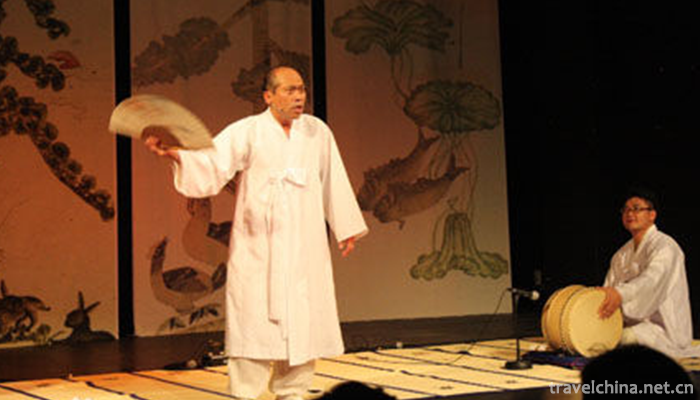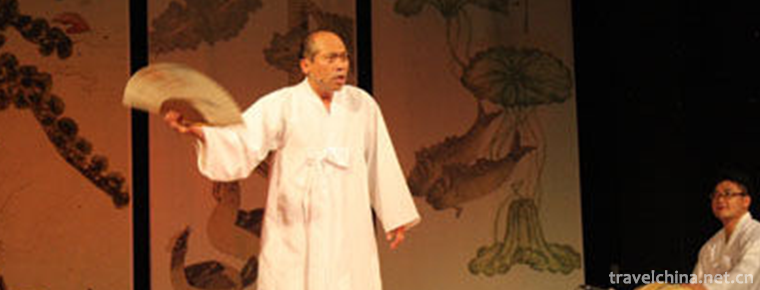Pansori
Pansori
The main art of Korean folk art is Pan Suo Li, which appeared in the 18th century. At the beginning of the 20th century, it was introduced into China with the immigration of Korean nationality. The word Pansori is a literal translation of Korean, meaning a song sung in public. Actors are mainly singing, combining rap and singing. A person can perform large-scale works with complex plots, such as Chun Xiang Zhuan and Shen Qing Zhuan.
On May 23, 2011, Pansori declared by Tieling City, Liaoning Province and Yanbian Korean Autonomous Prefecture, Jilin Province, was listed in the third batch of national intangible cultural heritage list with the approval of the State Council.
historical origin
The origin of Pan Suo Li can be traced back to the period of Suzong (1674-1720) of the Korean Dynasty, which was the period of the rise of Korean civilian culture. It had twelve collections. In the age of Britain and Zhengzu, there appeared "Pan Suoli's Eight Generations of Famous Singers". They expanded the scope of "beat" and "tune". By the end of the Korean Dynasty, Shen Zaixiao had changed the original twelve collections into six collections, which became the Pansori performance we saw today.
artistic characteristics
form
The word Pansori is a transliteration of Korean, meaning a song sung before the public. During the performance, one sits with drums and one stands with rap. In rap and singing, singing is the main method, combining rap and singing. Pansori is good at narration. Its traditional programs such as "Spring Fragrance Song" and "Shen Qing Song" are complex and have many characters. However, they are vividly portrayed by Pansori artists and deeply loved by the audience.
Pansori has a strong narrative, known as the "singing drama". When performing, "one person stands, one person sits, while the standing person sings, the sitting person is drummed", it is a traditional variety show popular with the Korean people. In addition, gossip is also one of the Korean folk art. This kind of music, which is performed by a single person, without makeup and props, is mostly satirical. The performers use various language skills, through "talking, learning and singing", are funny, humorous and lifelike, and are deeply loved by the masses. The Yanbian Quyi Troupe, founded in 1979, is one of the Korean professional art performing groups. It has created and performed such programs as "Yanbian Drum Book", "Three Old Men", "Yanbian Playing and Singing", "Ramble" and so on. It has strong national and local characteristics.
Music
Pansori's rhythm is unique. The so-called rhythm includes the speed, strength, height and rhythm of the rhythm. The main characteristics of the beat are as follows:
Chen Yang Diao: The slowest rhythm in the sandhi. Middle Molly: The slow 12-beat rhythm in a loose tune, often used for lyric or narrative. Molly in Middle School: faster than Molly in Middle School, often expressing grief or excitement. Molly: The 12-beat rhythm in loose tune is very fast, often used for listing and narrating. Wimmerley: The fastest four-beat rhythm in the loose key is used to express the panic scene.
major schools
Eastern stool system is mainly composed of painful sounds and feather tunes. It has a magnificent voice and a refreshing singing style. It can not see the continuous loudness and restrain the performer's own feelings. He is good at playing "Chibi Song".
The centre of the spread of Xiben system is Guangzhou, Luozhou, Baocheng, Kangjin and other places of Quanluodao. Soft timbre, trailing sound at the end, and good at decorative techniques.
The medium-high system is between the above two schools, and the timbre tends to be Eastern-style.
Representational repertoire
The five existing representative songs are: Chunxiang Song, Shenqing Song, Chibi Song, Shuigong Song and Xingfu Song.
The original twelve collections are: Spring Incense Song, Shen Qing Song, Xingfu Song, Rabbit Tortoise Song, Red Cliff Song, Pheasant's Call Ballad, Hengbiao Song, Yue's Call Ballad, Pei's Call Ballad, Jiangling Plum Blossom Call Ballad, Shu Ying Niang Zi Zhuan and Yongyi's Persistent Call Ballad.
Later, the six collections are: Spring Incense Song, Shen Qing Song, Xingfu Song, Hengxiao Song, Rabbit Tortoise Song and Red Cliff Song (Huarong Road)
Inheritance Significance
Although from the market point of view, Pansori's development is limited and performance opportunities are few, but Pansori's inheritance has far-reaching significance.


-
1.Black bean steamed pork ribs
Steamed pork ribs with lobster sauce is a traditional dish with color, aroma and taste. It belongs to Guangdong cuisine department. Cut the chopped pork ribs and add the marinade
Time 2018-11-02 -
2.Fuping Pottery Art Village
Pottery Village is located in the north of Fuping County. It relies on the site of Tang Dingzhou Kiln. It is a cultural and custom experience scenic spot consisting of a quasi-three-star hotel, three
Time 2019-01-12 -
3.Hailing Island Dajiao Bay Sea Silk Road Tourist Area Yangjiang City
Dajiaowan Scenic Area of Hailing Island in Yangjiang is located in Zhapo Town of Hailing Island, Yangjiang City, Guangdong Province.
Time 2019-01-13 -
4.Tianjin Water Park
Tianjin Water Park, formerly known as Qinglongtan, as a scenic resort, can be traced back to the beginning of the last century. It was officially opened to tourists on July
Time 2019-02-21 -
5.Yimeng Red Film and Television Base
Yimeng Red Film and Television Base, located in Changshan Villa, Ma Muchi Township, Yinan County, Linyi City, Shandong Province, was built in 2009. It is a comprehensive tourist area
Time 2019-03-03 -
6.Bouyei Leyou
Le You and Le Lang are Buyi oboe gas song instruments. They resemble suona, bowl-less, insect whistle playing, bright and sweet timbre. It can be used for Solo or singing accompaniment
Time 2019-04-04 -
7.Guilin fishing drum
Guilin fishing drum, commonly known as sentiment, is the local traditional rap and singing art of Guilin. The Song Dynasty was introduced into Guilin from the north,
Time 2019-05-02 -
8.Comba Rai
"Kangbalayi" is a poetic language of communication between Tibetan men and women in Zhiduo County. It originated in Songzan Period of Southern Japan in the end of the sixth century.
Time 2019-05-08 -
9.Mazu memorial ceremony
Mazu Festival, which originated in Song Dynasty, experienced Yuan, Ming and Qing dynasties and continued to expand and enrich. By the Qing Dynasty, Mazu was named "Tianhou", and the title re
Time 2019-05-15 -
10.Legend of the ancestors of Khitan
The legend of the ancestors of Qidan is a folk legend that is spread in Pingquan County, Hebei Province, China. According to legend, the ancestors of Qidan were born on the Futu River in Mayushan
Time 2019-06-10 -
11.Nanchong first industry
In 2019, the sown area of grain crops in Nanchong is 558000 ha, which is 0.15% lower than that in 2018. The sown area of oil crops is 152000 ha, an increase of 1.9% over that in 2018. The vegetable planting area is 154000 hectares, an increase of 3.9% over that in 2018.
Time 2020-12-17 -
12.Animal resources in Guangan
There are 14 families, 30 species of mammals, 11 orders, 36 families, 115 species of birds, 19 species of reptiles and 10 species of frogs in Guang'an City. The national first-class protected birds include the Tragopan, which is mainly distributed in the forest area of H
Time 2020-12-19